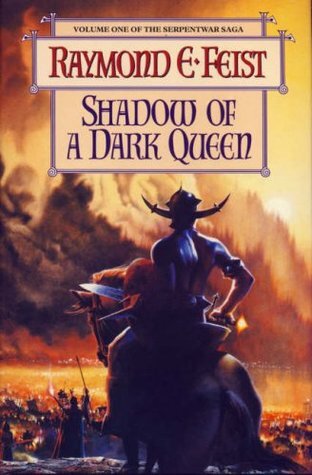Riftwar Re-Read #8 – Shadow of a Dark Queen
Right: I’ve spent far too many reviews in this series banging on about how dark and good the Serpentwar books are. It’s time to actually tell you about them.
 Introducing our new Cover Protagonist: Shirtless Bloke On Horse. Who is he? Where is his shirt? Only time and 3 more covers won’t tell.
Introducing our new Cover Protagonist: Shirtless Bloke On Horse. Who is he? Where is his shirt? Only time and 3 more covers won’t tell.Previously on Rift Space Nine: the Tsurani invaded, then an evil elf tried to blow up the world (but he was actually a snake), then everything was quiet for a bit, then some evil pirates tried to start a plague (but they were also actually snakes). Prince Arutha is a classic fantasy hero. Jimmy the Hand has gone from thief to politician. A boy called Pug is the most powerful wizard in the world, and his best mate Tomas is an elven demigod.
It is now twenty years later.
20 years. It’s a hell of a time-jump. Feist does a good job of subtly improving and changing bits of Kingdom society and tech – there’s a stock exchange now, the Navy is starting to look very Napoleonic, etc. – but it’s in the characters where the time jump and its consequences really hit home. Within the first 50 pages, offscreen, Arutha, Prince of Krondor, falls, breaks his hip, and dies. The original old guard, our epic heroes of the first books, are gone. (Except for Pug, obviously.) Their loss is keenly felt throughout this series. If people like Arutha had still been around, many characters think, maybe things wouldn’t have gone quite so wrong. But they’re dead and gone. There’s no going back.
The main character who thinks this, I am delighted to report, is of course good old Jimmy the Hand – the boy-thief who is now an old man and finally, finally, the Duke of Krondor. He’s in fine scheming form for this whole series, only now his scheming is turned towards the survival of the Kingdom, and preventing a very different kind of war to those Feist has described before.
In the Riftwar trilogy, the Riftwar itself comes out of nowhere. None of the protagonists are expecting the Tsurani invasion, and they’re all thrown headlong into the fighting alongside their own personal journeys. And because we’re focusing in the main on Pug and Tomas, and the actual war plotline with Arutha and company is half-focused on Kingdom politics and stopping the war, it feels much more like a straight epic than a ‘war story’. The battles in Sethanon are more in the latter vein, as we have a more conventional ‘bad guy’ trying to invade the Kingdom, but again we’re largely thrown straight into the action.
But in the Serpentwar, our protagonists know the war is coming. They’ve known since The King’s Buccaneer that the Pantathian Serpent Priests are going to try and burn the Kingdom to the ground. And so they’ve spent the last 20 years trying – and failing – to stop the Serpentwar before it starts.
The second main difference is in the choice of main POV characters. For pretty much the whole series so far, we’ve followed one or more members of the Kingdom’s royal family – Arutha, Borric and Erland, Nicky, etc. – alongside Pug, Jimmy and co. It’s all been noble men and women on noble quests to defeat the forces of darkness. While the protagonists of the Serpentwar are still trying to defeat the forces of darkness, they’re not doing it willingly, because – at first – they’re all desperate criminals who’ve traded a hanging for a suicide mission.
The first two books of the Serpentwar – Shadow of a Dark Queen and Rise of a Merchant Prince – are the buildup to the war itself. Erik von Darkmoor and Roo Avery are a pair of teenage murderers recruited at the gallows for an elite commando unit that sails to Novindus to gather vital intelligence about the upcoming invasion. It’s led, pleasingly, by Calis, half-elf son of good old Tomas, who is now a full-on badass. The first book deals with the recruitment of Calis’ Crimson Eagles and their first mission to Novindus. And it’s brutal. Feist pulls no punches in describing how tough the training is, how cut-throat the enemy – and the good guys – are. The description of Erik and Roo going to the gallows, to the point where the nooses go around their necks and the box gets kicked, is harrowing. All the Crimson Eagles are violent murderers already, and they’re being trained to be better violent murderers with extra loyalty. Even the returning characters are rendered more dark – Jimmy is a driven, haunted man; the bright, beautiful Gamina is reading minds in a courtroom to secure guilty verdicts. Even Nakor – the comic-relief magician – gets broody.
Erik is a good protagonist: he’s big and strong but also only 15 years old. His journey from scared child to extremely capable and motivated soldier is well-realised – all the convicts, it turns out, have some hidden depths to them. It’s also nice to see Novindus through fresh eyes, as it’s got some fresh elements to it. Giant lizard-men, for one thing. The Eagles are there not to fight the enemy army of the Emerald Queen, but to infiltrate it, and so we get to see the enemy from the inside. Which means, once again, encountering the Pantathian Serpent Priests, who in this book finally go from Mysterious Evil Snake-People to Motivated, Malicious Evil Snake-People. They want, it transpires, not just to invade the Kingdom, not just to conquer, but to get to the Lifestone, the great MacGuffin from the end of Sethanon. If they do, they will be able to destroy the entire world. Again, re-learning about these cosmic threats to existence through the fresh eyes of Erik is really refreshing: we know about the Dragon Lords and the Lifestone and lots of magic stuff already, but the reactions of a proper everyman to all this magic madness really hammers home how serious it all is. The character of Calis also forms a nice bridge between said magic madness – his father being Tomas, who is a Dragon Lord – and boots-on-the-ground practicality.
Ultimately, the mission to Novindus sees most of the protagonists die horribly. The intelligence they recover is, essentially, that the Kingdom is monumentally screwed, and there’s very little they can do about it. Even the B-plot of new magician Miranda tracking down Pug for a cosmic solution brings very little hope.
This is not Magician. This is not a tale of noble knights and wizards. This is a kingdom fighting to survive, and realising that in all likelihood, it won’t.
I really admire Feist for changing tack like this, in the middle of a long and established series. All those tales of heroism and derring-do after the original trilogy set a very different tone for what people must have expected from the Riftwar books to what Feist actually gave them. But it works. All that build-up helped make the world of Midkemia that much more vibrant and fleshed-out. It made me care about it that much more… which raises the stakes very nicely when it’s all about to go so very wrong.



